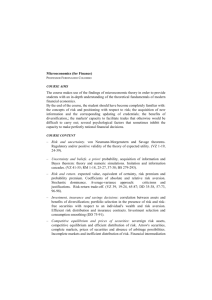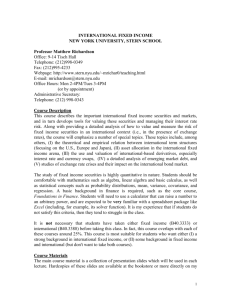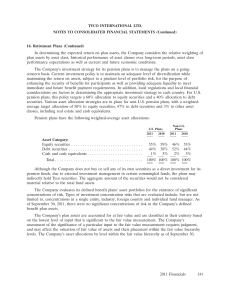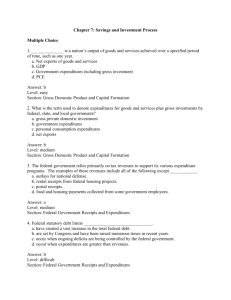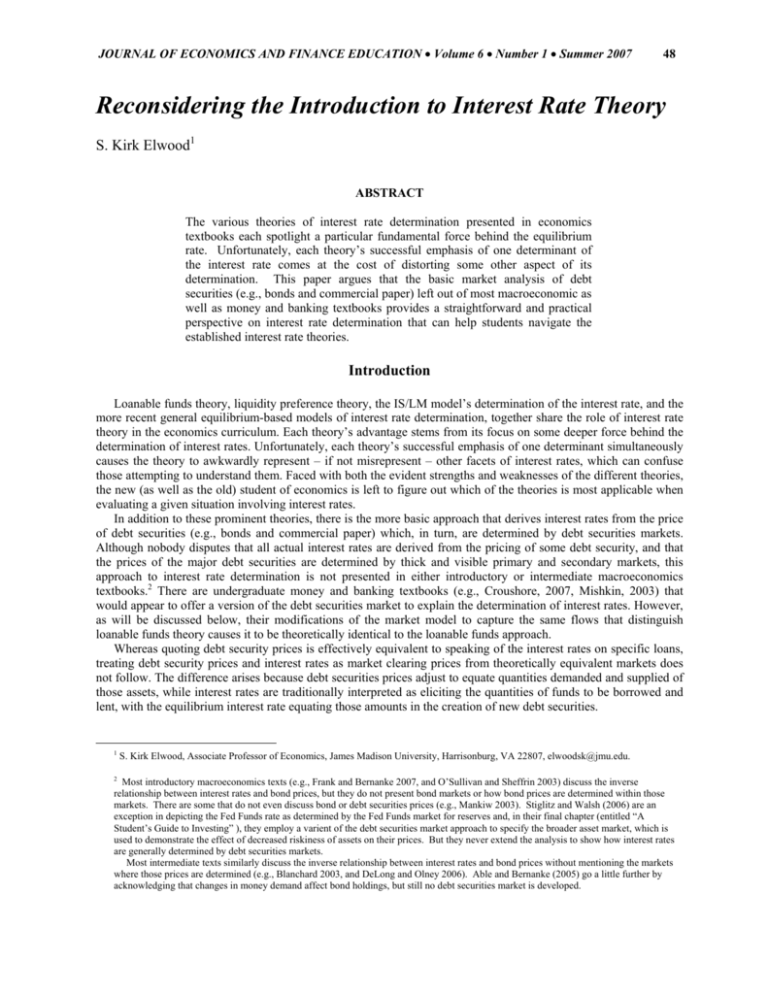
JOURNAL OF ECONOMICS AND FINANCE EDUCATION • Volume 6 • Number 1 • Summer 2007
48
Reconsidering the Introduction to Interest Rate Theory
S. Kirk Elwood1
ABSTRACT
The various theories of interest rate determination presented in economics
textbooks each spotlight a particular fundamental force behind the equilibrium
rate. Unfortunately, each theory’s successful emphasis of one determinant of
the interest rate comes at the cost of distorting some other aspect of its
determination. This paper argues that the basic market analysis of debt
securities (e.g., bonds and commercial paper) left out of most macroeconomic as
well as money and banking textbooks provides a straightforward and practical
perspective on interest rate determination that can help students navigate the
established interest rate theories.
Introduction
Loanable funds theory, liquidity preference theory, the IS/LM model’s determination of the interest rate, and the
more recent general equilibrium-based models of interest rate determination, together share the role of interest rate
theory in the economics curriculum. Each theory’s advantage stems from its focus on some deeper force behind the
determination of interest rates. Unfortunately, each theory’s successful emphasis of one determinant simultaneously
causes the theory to awkwardly represent – if not misrepresent – other facets of interest rates, which can confuse
those attempting to understand them. Faced with both the evident strengths and weaknesses of the different theories,
the new (as well as the old) student of economics is left to figure out which of the theories is most applicable when
evaluating a given situation involving interest rates.
In addition to these prominent theories, there is the more basic approach that derives interest rates from the price
of debt securities (e.g., bonds and commercial paper) which, in turn, are determined by debt securities markets.
Although nobody disputes that all actual interest rates are derived from the pricing of some debt security, and that
the prices of the major debt securities are determined by thick and visible primary and secondary markets, this
approach to interest rate determination is not presented in either introductory or intermediate macroeconomics
textbooks.2 There are undergraduate money and banking textbooks (e.g., Croushore, 2007, Mishkin, 2003) that
would appear to offer a version of the debt securities market to explain the determination of interest rates. However,
as will be discussed below, their modifications of the market model to capture the same flows that distinguish
loanable funds theory causes it to be theoretically identical to the loanable funds approach.
Whereas quoting debt security prices is effectively equivalent to speaking of the interest rates on specific loans,
treating debt security prices and interest rates as market clearing prices from theoretically equivalent markets does
not follow. The difference arises because debt securities prices adjust to equate quantities demanded and supplied of
those assets, while interest rates are traditionally interpreted as eliciting the quantities of funds to be borrowed and
lent, with the equilibrium interest rate equating those amounts in the creation of new debt securities.
1
S. Kirk Elwood, Associate Professor of Economics, James Madison University, Harrisonburg, VA 22807, elwoodsk@jmu.edu.
2
Most introductory macroeconomics texts (e.g., Frank and Bernanke 2007, and O’Sullivan and Sheffrin 2003) discuss the inverse
relationship between interest rates and bond prices, but they do not present bond markets or how bond prices are determined within those
markets. There are some that do not even discuss bond or debt securities prices (e.g., Mankiw 2003). Stiglitz and Walsh (2006) are an
exception in depicting the Fed Funds rate as determined by the Fed Funds market for reserves and, in their final chapter (entitled “A
Student’s Guide to Investing” ), they employ a varient of the debt securities market approach to specify the broader asset market, which is
used to demonstrate the effect of decreased riskiness of assets on their prices. But they never extend the analysis to show how interest rates
are generally determined by debt securities markets.
Most intermediate texts similarly discuss the inverse relationship between interest rates and bond prices without mentioning the markets
where those prices are determined (e.g., Blanchard 2003, and DeLong and Olney 2006). Able and Bernanke (2005) go a little further by
acknowledging that changes in money demand affect bond holdings, but still no debt securities market is developed.
JOURNAL OF ECONOMICS AND FINANCE EDUCATION • Volume 6 • Number 1 • Summer 2007
49
This distinction between debt securities prices and interest rates – on which more will be said below – is
supported by the fact that the actual markets where their joint values are determined are explicitly debt securities
markets. Bond markets – primary as well as secondary – and commercial paper markets quote either the prices or
discount rates of their debt securities, and leave the corresponding interest rate to be inferred. The “interest rate” is a
pricing term generally spoken outside of the larger financial markets by retail borrowers and lenders such as local
banks.3
In addition to the great familiarity with interest rates by those who borrow or lend through banks, most
economists dependably refer to interest rates instead of debt securities’ prices because it is assumed that economic
agents think in terms of interest rates when they assess the opportunity costs of intertemporal decisions. For
example, the opportunity costs of consumption/saving decisions as well as investment decisions are usually framed
in terms of interest rates.
The appeal of theories that specify interest rates instead of debt securities’ prices has helped advance and sustain
the longstanding loanable funds and liquidity preference theories. For example, the effect of an increase in saving on
the prices of real estate, equities, and gold is dependably represented by increases in the demands for those assets. It
is equally possible and correct to say that an increase in saving increases the demand for bonds and other debt
securities which, of course, raises their prices and lowers interest rates. But loanable funds theory intimates a closer
connection between saving and the interest rate, and is the theory of choice for characterizing how interest rates
depend on saving. It is interesting that the market approach suffices when determining other assets’ prices, but
another approach is more common when it comes to the price of debt securities, which determine the important
interest rates.
Liquidity preference theory can also be viewed as special treatment for interest rates. It is understood that
changes in money demand affect the markets for real estate, equities, and gold in the same way that they affect the
market for bonds and other debt securities. And whereas economists are satisfied to depict the effect of an increase
in money demand (assuming wealth is constant) as a decrease in the demand for other assets that lowers their prices,
the effect of changes in money demand on the demand and price of debt securities is overlooked in favor of a theory
in which money demand is more visibly linked to interest rates: liquidity preference theory.
Advancements in interest rate theory beyond the partial equilibrium loanable funds and liquidity preference
approaches have come in the form of theories that determine interest rates jointly along with the equilibrium level of
an economy’s aggregate output. The obvious interdependence between the two vital variables clearly recommends a
model in which they are both endogenous. This new dimension of interest rate theory was introduced by the IS/LM
model, was advanced by the seminal works of Grossman and Weiss (1983) and Rotemberg (1984), while more
recent contributions (e.g, Lucas 1990, Fuerst 1992, Christiano and Eichenbaum 1995) have cemented the standard
that new interest rate theory should be housed within a dynamic, general equilibrium framework. One of the issues
with these ambitious models is that actual interest rates are observed to change by the moment, whereas GDP is a
flow measured over periods of no less than a month. Interpreting a model that specifies both variables’ dynamic
paths forces one to either think in terms of equilibrium output changing by the moment, or, accept that the model’s
insights regarding interest rates concerns their average levels over one, three, or twelve month periods. In the latter
case, understanding the observed higher frequency movements in interest rates requires further explanation such as
that offered by the debt securities market approach to interest rates.
This paper proceeds in Section 2 by more formally assessing the renowned theories of the interest rate found in
the economics curriculum and identifying their weaknesses and complications that confuse many students and
compromise those who field their questions. Section 3 then demonstrates the strengths of the basic market model of
debt securities in explaining the determination of interest rates. It is not concluded that the debt securities market
approach to interest rates should replace the current textbook theories, but it is recommended as a sensible first step
into interest rate theory.
The Prominent Interest Rate Theories
Loanable Funds Theory
Illuminating the major concerns with the loanable funds approach to interest rates requires distinguishing
between the market model’s application to goods or services from its application to assets. Although the demand
and supply curves of the market model are more commonly employed to model the equilibrium price and quantity
3
The primary exception to this is the Fed Funds interest rate, but the nature of the Fed Funds market makes it particularly suited to speaking
of interest rates. The primary reason is that there is no secondary market for Fed Funds, but it is also the case that the interest rate on Fed
funds debt securities is effectively equal to their discount rate due to the brevity of their maturity.
JOURNAL OF ECONOMICS AND FINANCE EDUCATION • Volume 6 • Number 1 • Summer 2007
50
exchanged of some good or service during a period of time, they are also used to depict how the price of an asset is
determined at a given instant. However, the quantity specified in an asset market diagram does not represent the
cumulative amount from a flow over a period, but the entire stock of the asset that exists – whether changing hands
or not – at that instant. Accordingly, the supply curve for any given asset is usually depicted as vertical (and, at any
given instant, it is accurate to represent it as perfectly inelastic). As noted above, the moment’s equilibrium price of
debt securities directly corresponds to an equilibrium interest rate.
The loanable funds approach presents a market that specifies something different than debt securities being
traded. The quantities being demanded and supplied are funds, and the price in this market that adjusts to bring
about an equilibrium quantity to be exchanged is the interest rate. Upon the completion of a transaction a new debt
security is created. This loanable funds market is fundamentally different from the debt securities market in two
important respects.
First, the quantities demanded and supplied in the loanable funds market are flows and, as such, are modeled in
the same way as goods and services within the market model. Accordingly, the quantities specified are cumulative
amounts occurring over the course of the designated period. The interpretation of the equilibrium price in this type
of market model is as the average price of transactions that take place over the period. Of course, it can be just as
theoretically practical to model the average interest rate over a specified period as it is to model the average price of
bread or some other good or service. However, the fact that debt securities prices – and, therefore, interest rates – are
well-known to actually change by the second (in thick bond markets, for example) calls for an explanation of these
higher frequency interest rate dynamics that loanable funds theory does not provide. This does not diminish the
contribution of loanable funds theory to effectively demonstrate how flows of saving and investment influence
interest rates over time. But explaining the determination of a particular moment’s interest rate requires a theory that
distinguishes between moments.
The flow approach appeals to economists since a major source of new funds for lending is saving, which is a
flow. Furthermore, loanable funds are demanded to finance investment as well as some consumption (particularly of
consumer durables), which are also viewed as flows. But by focusing on flows during a given period, the approach
completely overlooks events leading up to that period that also affect the period’s interest rates. This means that – as
was mentioned in the introduction above – the loanable funds approach implicitly ignores the pre-existing stock of
debt securities, the size of which indisputably affects the price of debt securities during the period and, therefore, the
interest rate. By ignoring the pre-existing debt securities, the loanable funds approach implicitly assumes away all
secondary debt securities markets and their important roles in determining interest rates.
A conspicuous problem that stems from assuming away existing stocks of alternative assets is the approach’s
clumsiness in capturing the influence of money demand as well as money supply on the interest rate. Given that the
money supply is a stock, it is not surprising that the loanable funds’ flow approach is poorly equipped to capture
such effects. It is the loanable funds’ weakness in this area that increases the value of liquidity preference theory as
an additional theory of the interest rate. But liquidity preference theory and loanable funds theory are not easily
integrated.4 In fact, textbooks that include both theories usually present them independently in different chapters,
implicitly revealing that they are not complementary components of a broader theory of interest rates.5
As mentioned in the introduction, some money and banking textbooks (e.g., Croushore 2007, Mishkin 2003)
employ a bond market approach that appears similar to the debt securities market approach advocated in this paper.
But the debt security (or bond) market they offer illustrates the flow of new debt securities over a period of time
(and, accordingly has an upward sloping supply of debt securities) as opposed to collapsing the time-period down to
an instant under the asset market model approach described above (which depicts the supply of assets at a given
moment as perfectly inelastic). This flow version of the debt securities market is effectively the mirror image of
4
The degree of overlap and compatibility between the liquidity preference and loanable funds theories has not been agreed upon after
decades of examination. The loanable funds/liquidity preference “debate” extends back to Keynes who – in advancing his liquidity
preference theory – maintained that the classical loanable funds theory of interest rates was “a nonsense theory” (Keynes 1936, Chapter 14).
Since then there have been intermittent attempts to convincingly establish when and how the two theories are consistent with one another.
Some (e.g., Tsiang 1980) have argued that Keynes’ (1937) addition of the “finance motive” for the demand for money to his liquidity
preference theory makes the two theories equivalent. Others (e.g., Foley 1975, and Buiter 1980) claim that it is necessary to assume perfect
foresight for the two theories to uncover the same interest rate. While others (e.g., Davidson 1978, Mayer 1996) have echoed Hicks’ (1939)
argument that the two theories are equally “legitimate” (pg. 161) and dismiss any apparent differences as simply a spurious consequence due
to the difficulty of comparing the flow and stock specifications. After presenting a concise history of the debate, Bibow (2000) agrees with
others in the literature (e.g., Leijonhufvud 1981) that the issue is still unresolved and “remains a source of much confusion in modern
macroeconomics.” (pg. 825)
5
For example, Frank and Bernanke (2007) present the loanable funds theory in Chapter 9 and liquidity preference theory in Chapter 14, Hall
and Lieberman (2006) explain loanable funds theory in Chapter 7 and liquidity preference theory in Chapter 12, and Mankiw(2003) presents
loanable funds in Chapter 13 and liquidity preference in Chapter 20.
JOURNAL OF ECONOMICS AND FINANCE EDUCATION • Volume 6 • Number 1 • Summer 2007
51
loanable funds theory with the same strengths and weaknesses. E.G., it shows how saving and investment affects
debt security prices and interest rates while dismissing the influence of existing debt securities in its determination
of an average interest rate over periods of a month or more.
Liquidity Preference Theory
Liquidity preference theory employs the market approach to assets as described above, where the asset modeled
is money. Accordingly, it claims to describe a momentary equilibrium price of the asset. But the price of this asset –
i.e., money – is invariant in terms of the unit of account, which is, of course, money. So while the horizontal axis of
the standard liquidity preference diagram represents the quantity of money circulating in an economy, it is not
meaningful to have the “price of money” on the vertical axis. Instead, liquidity preference theory employs a variable
that varies inversely with the price of a substitute asset for money on the vertical axis. Specifically, the vertical axis
represents a variable that varies inversely with the price of debt securities: the interest rate. The quantity demanded
of money is negatively related to this inverse of the price of debt securities, thus the liquidity preference diagram has
a downward sloping “demand for money.”
This modification of the market model in which the price of the good or asset being modeled is replaced by a
variable that varies inversely with the price of a substitute good or asset is, at the very least, bizarre to the new
student of economics. Unfortunately, further inspection of the technique does not help rationalize the particular
modification. Essentially, it is equally correct to say that the inverse in the price of widgets (or any other good,
service, or asset) is negatively related to the quantity of money demanded. This is because higher widget prices
causes people to buy fewer widgets, thereby indicating their greater desire to hold money. The same is equally true
for equities (or other assets such as gold or real estate), since an increase in the price of equities causes people to
hold fewer equities and more money. Therefore, it is just as meaningful to have a liquidity preference theory where
money demand is viewed as negatively related to the yield on equities (which is inversely related to the price of
equities) instead of the return on debt securities. However, this seemingly equivalent approach has never been
deemed useful in explaining the determination of equity prices.6
Perhaps more importantly, the narrow focus of the theory makes it awkward at capturing other very important
determinants of the interest rate. For example, the sale of new securities by the US Treasury or US businesses would
cause their prices to fall and interest rates to rise. Since the money supply is unchanged, liquidity preference theory
could only represent the change by an increase in money demand. But the liquidity preference perspective does not
provide a straightforward reason why money demand would increase as a result of an increase in the stock of
bonds.7 Of course, the student is advised to think in terms of loanable funds instead of liquidity preference in this
situation.
The obvious strength of liquidity preference theory is its predictions regarding changes in money supply and
money demand on the interest rate. But it occasionally proves to be erroneous in that domain as well. Consider the
case of an increase in expected inflation: It causes money demand to fall which, if considered in a strict liquidity
preference context, reduces interest rates. This prediction is unequivocally wrong.
Even though the debt securities market approach to interest rates does not suffer from these problems, this paper
does not advocate that it should replace either the liquidity preference or the loanable funds theories. It is merely
suggested that a student would benefit from a practical model of interest rates based on simple and familiar market
mechanics before encountering more sophisticated theoretical approaches.
The IS-LM Approach to Interest Rates
Admittedly, many students are sufficiently occupied with understanding how the IS-LM model functions that
they never question the reasoning behind its construction. But the model’s ambitious goal of determining
equilibrium aggregate output in conjunction with the equilibrium interest rate gives rise to questions by those
students who do. This feature of the model makes it difficult to reconcile the model with the most basic economic
data, since the flow of aggregate output is measured at a quarterly or annual frequency while interest rates are
observed to change every few seconds in the debt securities markets. The discrepancy is avoided by the
interpretation of the equilibrium interest rate from the IS-LM model as an average interest rate over the entire
6
The technique could also generate other potential theories, e.g., the equity preference theory (where the demand for equities is negatively
related to the interest rate) or the real estate preference theory (where the demand for real estate is inversely related to the interest rate).
7
This is not to suggest that a liquidity preference interpretation does not exist. For example, an explanation of how increases in the supply of
bonds begets greater money demand starts with maintaining that the acquisition of new bonds would – at the initial interest rate – disturb
people’s preferred mix of bonds and money (and other assets) in their portfolio in the direction of having too many bonds. They resulting
exchange of bonds for money would be viewed as an increase in money demand.
JOURNAL OF ECONOMICS AND FINANCE EDUCATION • Volume 6 • Number 1 • Summer 2007
52
period, just as is assumed to be in the loanable funds approach. Again, as was mentioned with regard to the loanable
funds approach, the specified average interest rate over the period may capture the fundamentals of greatest
importance to the understanding the determination of aggregate output. It is just that the specification does not
provide insights to the high frequency movements in interest rates that are observed.
Another source of confusion and concern is the fact that the IS curve and its representation of goods market
equilibrium involves the real interest rate, while the LM curve and its representation of financial market equilibrium
depends on the nominal interest rate. The most common textbook approach to addressing this inconsistency is to
(either explicitly or implicitly) force the two rates to be equivalent by assuming that expected inflation is zero. But
this begs the question of the effects of expected inflation, which are argued in all other contexts to significantly
influence interest rates. Some economists have attempted to incorporate expected inflation into the model by either
shifting the IS curve (when the nominal interest rate is specified) or LM curve (when the real interest rate is
specified) by the change in level of expected inflation. But this is also complicated by the resulting models’ common
prediction that an increase in expected inflation unambiguously increases output in the short run.8
The IS-LM model also suffers the loanable funds problem of being unable to represent the impact of pre-existing
debt securities at the beginning of the period being modeled. The flows driving the IS curve are just as unconcerned
about the stock of existing debt securities as the comparable flows are in the loanable funds approach. Meanwhile,
the LM curve – which essentially incorporates liquidity preference theory into the IS-LM model – offers no better
accounting for the prevailing stock of debt securities than liquidity preference theory does.
These problems with the IS-LM model do not justify discarding it from the economics curriculum. Theoretical
models that capture aspects of how aggregate output and interest rates are interrelated offer valuable insights.
However, providing students with a practical explanation of interest rate determination will better prepare them for
the more sophisticated theoretical examinations of the deeper forces that determine market interest rates.
Dynamic General Equilibrium Models of the Interest Rate
More recent interest rate theory has not attempted to discover a better partial equilibrium approach in the mold of
a loanable funds or a liquidity preference theory, but has concentrated on models that improve upon the joint
determination of output and the interest rate as found in the IS-LM model. Real business cycle theory has effectively
established the supremacy of dynamic models of output over static models, and for more than two decades
economics journals and the graduate economics curriculum have examined output using dynamic models. The high
level of mathematical skill required to construct and solve these models has prevented undergraduate textbooks from
specifying particular examples. These textbooks merely outline real business cycle theory, leaving space in the
curriculum that the IS-LM model continues to fill.
The ascendance of dynamic models of output has set a parallel standard for interest rate theory, where recent
proposed theory has been via dynamic, general equilibrium models where the path of the interest rate across time is
appropriately interrelated with the dynamic path of output. Many of these models are concerned with demonstrating
how monetary shocks (i.e., changes in liquidity) influence output as well as interest rates (e.g., see Lucas 1990,
Fuerst 1992, and Christiano and Eichenbaum 1995). Despite the success of these models, their joint treatment of
output and interest rates has not escaped the same frequency problem that troubles the loanable funds and IS-LM
models, i.e., the fact that output is measured as flows over periods of time of at least a month while interest rates are
tied to asset prices that can change with every succeeding moment. Versions of these models are found in both
continuous and discrete time specifications. Whereas the continuous time specifications might seem fitting for the
dynamic path of interest rates, it is difficult to grasp the idea of output changing at the same frequency. On the other
hand, the models specifying a sequence of discrete periods necessarily disclose the behavior of average interest rates
over each period.
It is important to note that the debt securities market approach to interest rates neither contradicts nor
compromises these newer theories. For example, the market-based determination of the interest rate is perfectly
consistent with the theoretical premise that the interest rate adjusts to clear the goods market. The debt securities
market approach merely adds a means to understanding observed interest rate behavior across minutes as well as
months.
The Debt Securities Market Approach to Interest Rates
8
This is consistent with the so-called Mundell-Tobin effect, which predicts that real interest rates fall with greater expected inflation
promoting more investment and consumption.
JOURNAL OF ECONOMICS AND FINANCE EDUCATION • Volume 6 • Number 1 • Summer 2007
53
As noted in the introduction, all interest rates are derivative of the price of some debt security. Because debt
securities are assets, it is appropriate to model the debt securities market using the asset form of market analysis as
described above. It is important to recognize that any criticism of the debt securities market approach to interest
rates is equally valid for the market analysis of any asset. In particular, the collapsing of the time frame down to an
instant and the associated perfectly inelastic supply at a quantity representing the amount potentially tradable rather
than the quantity transacted, both alter the analysis from the standard market analysis of flows of goods or services.
The resulting model can only represent the effect of a flow of newly created assets as lateral shifts in the vertical
supply curve, which some might view as a relatively clumsy way of representing that flow.
However, economists in general, and financial economists in particular, have come to terms with the asset
version of the market model for other assets. As one example, economics textbooks commonly specify a vertical
supply curve when examining the housing market. The accompanying discussion inevitably points out that the
higher the price of housing, the greater the incentive to generate new housing. And as houses are added to the
housing stock the vertical supply curve moves to the right. Another example is the equities market, where increases
in the stock of equities are represented as rightward shifts of a vertical supply curve. Given that the approach is
considered a legitimate way to model other assets’ prices, it is equally viable for determining debt securities’ prices
and, therefore, interest rates.
The debt securities approach is a practical introduction to interest rate determination that fosters sound economic
and financial intuitions. To demonstrate the model’s capacity to adroitly capture and reflect the range of factors that
influence interest rates, consider how it captures the effect of:
1) Saving – increases the demand for assets including debt securities, causing the price of debt securities to rise
and interest rates to fall.
2) Increases in the expected productivity of future capital – increase the supply of bonds and other debt
securities as investors willingly supply new debt securities (i.e., promises to pay back fixed amounts in the
future) at lower prices, causing the equilibrium price of debt securities to fall and interest rates to rise.
3) Increases in expected inflation – reduce the desirability of holding bonds and other debt securities, decreasing
their demand and their prices, thus, causing interest rates to rise.
4) Increases in the riskiness of equities – increase the demand for debt securities, which increases their prices
and lowers interest rates.
5) The sale of new debt securities (e.g., government bonds) – increases the stock (and, therefore, the supply) of
debt securities, causing their prices to fall and interest rates to rise.
6) Increases in nominal money demand (assuming constant wealth) – require either decreases in the demand for
one or more of the other assets where wealth is held, and/or a decrease in the demand for goods. To the extent
that the increased demand for money is the flipside of a fall in the demand for debt securities, it will lower the
price of debt securities and raise interest rates. Note that this holds for greater nominal money demand due to
increases in the general price level.
7) Increases in the expected future price of debt securities and, therefore, lower interest rates – increases the
demand for debt securities as people now expect their value to increase. This causes the price of debt securities
to rise and interest rates to fall.
And finally:
8) Increases in the money supply via open market purchases of government securities by the central bank in a
fractional reserve banking system – influence the market for debt securities in two ways. First, the purchase and
continued possession of the government securities represents an increase in the demand for debt securities by
the central bank. In addition, the corresponding increase in reserves permits profit-maximizing banks to
purchase more debt securities, either in the form of new loans, commercial paper, or secondary reserves (i.e.,
government securities). Both of these increases in the demand for debt securities push up their prices and lowers
interest rates. Similar employment of the model predicts an increase in interest rates due to open market sales.
These examples exhibit the power of the simple model to provide straightforward, uncomplicated, yet accurate
insights to the determination of the interest rate. Again, the model is not advocated as a substitute for any of the
established theories, but as a complementary approach that adds to one’s perspective on interest rates.
Conclusion
Each of the interest rate theories presented in macroeconomic as well as money and banking textbooks seek to do
more than provide standard, partial equilibrium analysis of the determination of the interest rate. They each provide
special emphasis of a fundamental determinant of the interest rate. It could be argued that, as a group, the theories
provide a way to analyze the effects of a variety of variables on the interest rate. But each of these theories by
JOURNAL OF ECONOMICS AND FINANCE EDUCATION • Volume 6 • Number 1 • Summer 2007
54
themselves – in emphasizing a particular determinant – misrepresent the interest rate environment to the point that
they are either inept or incorrect in capturing other aspects of the determination of interest rates. The glaring nature
of these problems can be confusing to the new student of economics and finance.
This paper does not recommend rejecting any of the established theories, but it does advocate presenting the debt
securities market approach to the interest rate before introducing the other theories. Although the market approach to
assets differs from the standard market approach to goods and services, it is no more difficult to interpret and is
often a valuable tool when examining financial phenomena. Grounding the student with a straightforward model of
interest rates that effectively captures the effects of all types of shocks can help students develop a more
comprehensive understanding of interest rates.
JOURNAL OF ECONOMICS AND FINANCE EDUCATION • Volume 6 • Number 1 • Summer 2007
55
References
Able, Andrew .B., and Ben. Bernanke. 2005. Macroeconomics. San Francisco: Pearson-Addison Wesley.
Croushore, Dean. 2007. Money and Banking: A Policy-Oriented Approach. Boston: Houghton Mifflin.
Bibow, Jorg. 2000. The loanable funds fallacy in retrospect. History of Political Economy 32 (Winter): 789-831
Blanchard, Olivier. 2003. Macroeconomics 3rd ed. Upper Saddle River, New Jersey: Prentice Hall.
Buiter, Willem H. 1980. Walras’ law and all that: budget constraints and balance sheet constraints in period models
and continuous time models. International Economic Review 21.1:1–16.
Christiano, Lawrence J., and Martin Eichenbaum. 1995. Liquidity effects, monetary policy, and the business cycle.
Journal of Money, Credit, and Banking 27 (November): 1113–1136.
Davidson, Paul. 1978. Money and the real world. 2nd ed. London: MacMillan.
DeLong, J.Bradford and Martha Olney. 2006. Macroeconomics 2nd ed. Boston: McGraw-Hill Irwin.
Foley, Duncan K. 1975. On two specifications of asset equilibrium in macroeconomic models. Journal of Political
Economy 83 (April):303-24.
Frank, Robert and Ben Bernanke. 2007. Principles of Macroeconomics. 3rd ed. Boston: McGraw-Hill Irwin.
Fuerst, Timothy. 1992. Liquidity, loanable funds, and real activity. Journal of Monetary Economics 29 (February):
3–24.
Grossman, S., and L. Weiss. 1983. A transactions-based model of the monetary transmission mechanism.
American Economic Review 73 (December): 871–80.
Hall Robert and Marc Lieberman 2006. Macroeconomics: Principles and Applications. 3rd ed. Cincinnati: Thomson
South-Western.
Keynes, John Maynard 1936. The General Theory of Employment, Interest, and Money. New York: Harcourt,
Brace & World, Inc.
Keynes, John Maynard 1937. Alternative theories of the rate of interest. Economic Journal 47 (June)
Leijonhufrud, Axel. 1981. Information and coordination. Oxford: Oxford University Press.
Lucas, Robert E. 1990. Liquidity and interest rates. Journal of Economic Theory 50 (April): 237– 64.
Mankiw. N.Gregory. 2003. Principles of Macroeconomics. 3rd ed. Philadelphia: Harcourt College Publishers.
Mayer, Thomas. 1996. Money, Banking, and the Economy. 6th ed. New York: Norton.
Mishkin, Frederic. 2003. The Economics of Money, Banking, and Financial Markets. 6th ed. Boston: Addison
Wesley.
O’Sullivan, Arthur and Steven Sheffrin. 2003. Macroeconomics: Principles and Tools. 3rd ed. Upper Saddle River,
New Jersey: Prentice Hall.
Rotemberg, Julio. 1984. A monetary equilibrium model with transactions costs. Journal of Political Economy 92
(February): 40–58.
JOURNAL OF ECONOMICS AND FINANCE EDUCATION • Volume 6 • Number 1 • Summer 2007
56
Tsiang, S.C. 1980. Keynes’ demand for liquidity, Robertson’s loanable funds theory, and Friedman’s monetarism.
The Quarterly Journal of Economics 94 (May): 467-91.


